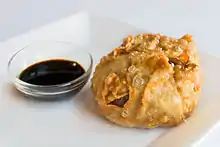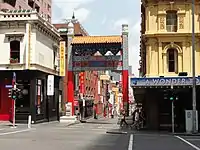Chinatown, Melbourne
Chinatown (Chinese: 墨爾本華埠) is an ethnic enclave in the Central Business District (CBD) of Melbourne, Victoria, Australia. Centred at the eastern end of Little Bourke Street, it extends between the corners of Swanston and Spring Streets, and consists of numerous laneways, alleys and arcades. Established in the 1850s during the Victorian gold rush, it is notable for being the longest continuous Chinese settlement in the Western World and the oldest Chinatown in the Southern Hemisphere.[1][2][3]


Melbourne's Chinatown has played an important role in establishing the culture of Chinese immigrants in Australia, and is still home to many Chinese restaurants, cultural venues, businesses and places of worship. Today, Melbourne's Chinatown is a major tourist attraction, known for its architectural heritage, annual festivals and cuisines of Chinese, Thai, Japanese, Indian, Malaysian, Vietnamese and Korean origins.[4]
Beyond Chinatown and the CBD, Melbourne's Chinese community is well-represented in other areas of the city, most notably Box Hill, where a $450 million development named "New Chinatown" is currently being constructed.
Chinatown is home to the Chinese Museum.
History
Early history

Melbourne's Chinatown has a long and illustrious history. It was established during the Victorian gold rush in 1851 when Chinese prospectors came to Australia for the gold rush in search of gold. In late 1854, the first Chinese lodging houses were created in Little Bourke Street and Celestial Avenue (off Little Bourke Street).[5] This particular location was considered convenient for the immigrants, as it was a staging post for new Chinese immigrants as well as supplies en route to the goldfields. It is notable for being the oldest Chinatown in Australia,[6] the oldest continuous Chinese settlement in Australia, and the longest continuous Chinese settlement in the western world, only because San Francisco's Chinatown was destroyed by the 1906 earthquake.[7] The gold rush eventually waned, causing a shift from rural living and an influx of people migrating into metropolitan Melbourne, particularly Little Bourke Street, which already had a predominantly Chinese population.

The Chinese established themselves as storekeepers, importers, furniture-makers, herbalists and in the wholesale fruit and vegetable and restaurant industries. Christian churches were built and Chinese political groups and newspapers were subsequently formed.[5] Other members of the Chinese community who lived and worked elsewhere used Chinatown to congregate with friends. The area also provided further support to new Chinese immigrants. Early in its history, during a thriving period in the 1850s, Chinatown housed "salubrious" enterprises including opium dens, brothels and boarding houses, but maintained a distinctly "entrepreneurial air".[8] By 1859, Victoria's Chinese population reached approximately 45,000, representing nearly 8.5% of the colony's total population.[9]
Australian colonial author Marcus Clarke wrote in 1869:
One-half of Little Bourke-street is not Melbourne but China. It is as though some djinn or genie had taken up a handful of houses from the middle of one of the Celestial cities, and flung them down, inhabitants and all, in the Antipodes. One almost expects to behold the princess on her way to the bath, or to meet that mighty potentate the brother to the sun, uncle to the moon, and first cousin to the seven stars.[10]
During the colonial period, several businesses run by Australians of European descent were based in Chinatown, including the offices of Table Talk, for a time in the 1880s one of Melbourne's most popular magazines.
Chinatown peaked in the early 20th century in terms of population and activity, which was hampered by the 1901 Immigration Restriction Act and a general shift of businesses and residents from the Melbourne's central business district (CBD).[5] The Dim Sim was invented in Chinatown, by William Wing Young, in 1945, at his restaurant Wing Lee, and has become a major snack food in takeaway outlets and Chinese restaurants throughout the entire country. European residents of Melbourne and university students of the city began frequenting Chinatown eateries in the 1930s, leading to gradual mainstream Australian popularity which boomed in the 1960s–70s. This boom was further enlarged by the redevelopment of Little Bourke Street at the request of Chinatown entrepreneur David Neng-Hsiang Wang, leading to the archways of today.[11]
1970s–present day


The Southern Chinese people (who first settled in Melbourne) were the first Chinese Australians to bring Chinese cuisine to Australia, although recently more Northern Chinese food has become common. Chinese food was the first international cuisine to become popular through the take away food market in Australia. The 1970s and 80's also saw the eradication of the controversial discriminatory immigration regulations, which saw immigration from Indochina, Singapore, Malaysia, Taiwan, Hong Kong and the People's Republic of China. In 2010, the ground floor of the Chinese Museum was remodeled as a visitor centre for Melbourne's Chinatown. In 2011, a Memorial statue of Dr Sun Yat-sen was unveiled outside the Museum's entrance in celebration of the 100th anniversary of the founding of the Republic of China. The traditional Chinese New Year Lion Dance has always ended at this spot, but will now end with a blessing of the statue.[12][13]
Culture
Chinese New Year

The Chinese New Year is primarily celebrated in Chinatown on the first Sunday of the new Lunar year. It is the original and primary location of Melbourne's CNY festival, although the festival has expanded to multiple CBD sites in recent years, including Crown Casino. The celebrations feature traditional and contemporary Chinese cultural activities and festivities, dances, Chinese opera and singing, karaoke competition, numerous stalls of culinary delights, arts and crafts, Chinese chess competitions, calligraphy and children's events.

The Dai Loong Dragon Parade, as well as the main Lion Dances (performed by the Chinese Youth Society of Melbourne, Chinese Masonic Society and Hung Gar Martial Arts School) begin at roughly 10am on the Sunday following New Year, and run till roughly 4pm. The Dragon parade begins and ends at Melbourne's Chinese Museum.[14]
Asian Food Festival
The Asian food festival is typically held in Spring and celebrates Asian cuisine with food tasting, stalls, cooking demonstrations, among others.
Other Chinese communities
Beyond the original Chinatown in the CBD, several newer Chinese communities have developed in Melbourne's eastern suburbs, such as Box Hill, Glen Waverley and Springvale.
An older community, with links back to the 1850s gold rush, is to be found in the regional city of Bendigo, 150 km north-west of Melbourne.
Cultural depictions
Tom Roberts, one of the leading figures of Australian Impressionism, created sketches of life in Little Bourke Street in the 1880s. During the Second World War, modernist Eric Thake created a series of works depicting Chinatown shopfronts, which now belong in the State Library of Victoria's painting collection.
Fergus Hume's The Mystery of a Hansom Cab (1886), one of the most famous mystery crime novels of the Victorian era, is based largely on the author's observations of life in Little Bourke Street, including the "dark recesses" of the Chinese Quarter, where Detective Kilsip, the novel's protagonist, pursues his suspect. Alfred Dampier's Marvellous Melbourne play of the same year features a scene in a Chinatown opium den.
Set in Little Bourke Street, Elinor Mordaunt's 1919 novel The Ginger Jar is about a love affair between a Chinese Australian hawker and a European woman.
A pivotal scene of the 1911 silent film The Double Event, directed by W. J. Lincoln, takes place in Melbourne's Chinatown.
The 1997 Hong Kong action film Mr. Nice Guy, starring Jackie Chan, is set in Melbourne, with several scenes shot in Chinatown.
Heritage sites

Archways
 Exhibition Street
Exhibition Street Russell Street
Russell Street Swanston Street
Swanston Street
References
- "Chinatown Melbourne". Retrieved 23 January 2014.
- "Melbourne's multicultural history". City of Melbourne. Retrieved 23 January 2014.
- "World's 8 most colourful Chinatowns". Retrieved 23 January 2014.
- http://chinatownmelbourne.com.au/ChinatownMelbourneBrochure2012.pdf
- "Melbourne's Chinatown - Little Bourke Street area (Victoria) (c. 1854 - )". Chinese Museum of Australia. Retrieved 23 January 2014.
- City of Melbourne. "Multicultural communities - Chinese". Archived from the original on 4 October 2006. Retrieved 2006-10-13.
- Bacon, Daniel: Walking the Barbary Coast Trail 2nd ed., pages 52-53, Quicksilver Press, 1997
- Brown, Lindsay; Vaisutis, Justine; D'Arcy, Jayne (2010). Australia. p. 210.
- Hing-wah, Chau; Karine, Dupre; Xu, Bixia (2016). "Melbourne Chinatown as an Iconic Enclave" (PDF). Proceedings of the 13th Australasian Urban History Planning History Conference. Icons: The Making, Meaning and Undoing of Urban Icons and Iconic Cities. Melbourne: Griffith University. pp. 39–40.
- The Argus, 9 March 1868, p. 5.
- Fincher, Ruth; Jacobs, Jane Margaret (1998). Cities of Difference. p. 210.
- "Chinese Museum Profile 2012" (PDF). Museum of Chinese Australian History Incorporated. Archived from the original (PDF) on 12 April 2019. Retrieved 19 June 2013.
- "Chinese Youth Society of Melbourne". cysm.org. Chinese Youth Society of Melbourne. Archived from the original on 29 July 2012. Retrieved 23 January 2012.
- "Chinese New Year Festival 2014". Retrieved 23 January 2014.
External links
| Wikimedia Commons has media related to Chinatown, Melbourne. |
- Chinese Museum Museum of Chinese Australian History.
- Chinatown Precinct Association website